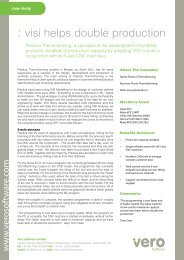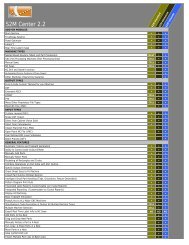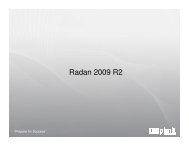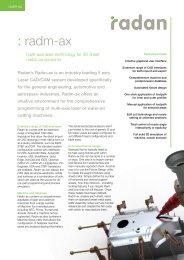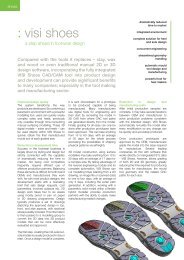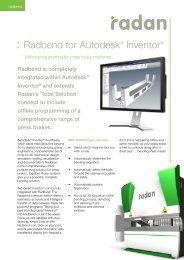: peps pentacut - Vero Software
: peps pentacut - Vero Software
: peps pentacut - Vero Software
You also want an ePaper? Increase the reach of your titles
YUMPU automatically turns print PDFs into web optimized ePapers that Google loves.
laser<br />
intuitive graphical user interface<br />
extensive range of CAD interfaces<br />
for both import and export<br />
: <strong>peps</strong> <strong>pentacut</strong><br />
Multi-axis laser technology for 3D sheet<br />
metal components<br />
comprehensive machine and<br />
postprocessor database<br />
locate large parts with simplified<br />
part location system<br />
automated fixture design<br />
one-click application of toolpath<br />
for inner and outer profiles<br />
manual application of toolpath<br />
for selected areas<br />
PEPS Pentacut is an industry leading 5 axis<br />
Laser CAD/CAM system developed specifically<br />
for the general engineering, automotive and<br />
aerospace industries. PEPS Pentacut offers an<br />
intuitive environment for the comprehensive<br />
programming of multi-axis laser or water-jet<br />
cutting machines.<br />
Extensive range of CAD interfaces<br />
PEPS Pentacut comes with an<br />
extensive range of integrated CAD data<br />
translators that allow the direct import<br />
of CAD drawings in their native form or<br />
as industry standards, such as IGES,<br />
STEP and DXF. The standard system<br />
configuration comes with interfaces<br />
for DXF, AutoCAD DWG, AutoCAD-<br />
Inventor, VISI, SolidWorks, Solid Edge,<br />
IronCad and IGES. Optional CATIA V4,<br />
CATIA V5, Unigraphics, Pro Engineer,<br />
VDA and STEP translators are<br />
available. PEPS Pentacut can display<br />
the CAD data as simple wireframe,<br />
solids and surfaces or a combination of<br />
both; which are used as the source for<br />
all cut-path programming and process<br />
simulation.<br />
Machine and database<br />
PEPS Pentacut contains a<br />
comprehensive database of laser<br />
and water-jet machines from a<br />
large number of Machine Tool<br />
manufacturers; including NTC, Prima,<br />
Trumpf and Amada. Should a machine<br />
not be supported, PEPS Pentacut<br />
also contains a Machine Setup<br />
utility that allows the configuration<br />
of bespoke machine types and<br />
postprocessing information. The<br />
advanced postprocessors aren’t just<br />
limited to the use of generic G and M<br />
codes; posts are easily configured to<br />
suit different head configurations and<br />
table sizes.<br />
Automated fixture design<br />
Stamped forms typically need to be<br />
held using fixtures and within PEPS<br />
Pentacut this can be done in a number<br />
of ways. One way is to import clamps<br />
and fixtures from external files and<br />
then manually reposition them. Another<br />
way is to use the Fixture Design utility<br />
to create the support fixtures using<br />
sheet metal. Simply define the number<br />
of horizontal and vertical support<br />
sheets, how they interlock - including<br />
locking features if you require them -<br />
and how they run-off the part. Once<br />
these details have been defined, PEPS<br />
Pentacut creates each sheet, nests<br />
them on standard sheet metal sizes,<br />
adds assembly notes such as number<br />
references and creates the NC code<br />
with which to manufacture them.<br />
edit cut technology and nozzle<br />
setting at unlimited positions<br />
total control of nozzle angle<br />
interactively or explicitly<br />
create and apply technology<br />
data at any point<br />
inter- and intra-cut collision<br />
detection<br />
full solid 3D simulation of<br />
machine, nozzle and part
laser<br />
By using PEPS Pentacut, not only will programming time be minimised,<br />
the eventual cut-path will be far more efficient, saving further time on<br />
the machine. Add in the comprehensive simulation and proofing tools<br />
and you have a system that not only streamlines day-to-day production,<br />
it also reduces costly errors and eradicates the need for dry-runs.<br />
Cutting-path creation<br />
Cutting operations within PEPS<br />
Pentacut can generally be divided<br />
into two areas: inner and outer trims.<br />
Outer trims are the external forms of<br />
the part whilst inner trims represent<br />
the internal cut-outs and other features<br />
to be machined. The basic toolpaths<br />
for these cutting operations can<br />
be automatically generated by the<br />
automation tools built into to PEPS<br />
Pentacut. User interaction is available<br />
for all toolpath types to allow for<br />
manual creation and refinement. PEPS<br />
Pentacut provides a great amount of<br />
control over how each inner or outer<br />
trim is handled; for example, creating<br />
micro-joints to hold the material in<br />
place until processing is finished<br />
becomes quick and uncomplicated.<br />
The toolpath can also be edited in<br />
terms of how the cutting nozzle is<br />
angled towards it or how it handles jigs<br />
and fixture features.<br />
Reduce machine wear<br />
PEPS Pentacut has a wealth of in-built<br />
features that allow for the optimisation<br />
of the laser toolpath. For example,<br />
by smoothing out the toolpath in<br />
areas around tight corners or small<br />
features, PEPS Pentacut will optimise<br />
the toolpath to reduce the wear on<br />
the machine tool at the same time;<br />
ensuring that feeds and speeds are<br />
maintained across the job.<br />
.<br />
Toolpath verification and simulation<br />
Within PEPS Pentacut the toolpaths<br />
are presented showing the angle of<br />
the nozzle as it moves around the part.<br />
Instant feedback is provided about<br />
whether or not a specific move is<br />
possible - either in terms of machine<br />
head movement limits or accessibility.<br />
Any collisions that are detected are<br />
highlighted both on the model and via<br />
on-screen messages. The trim-path<br />
parameters can be edited directly or,<br />
in the event of a collision, automatically<br />
corrected at any time; ensuring that<br />
your toolpath is both safe and using<br />
the optimum strategy to reduce<br />
processing time. Once the toolpath<br />
has been optimised, simply select the<br />
piercing and cutting conditions from<br />
the pre-defined technology tables<br />
and PEPS Pentacut quickly generates<br />
reliable NC code.<br />
NC code simulation<br />
The NC code can be re-imported into<br />
PEPS Pentacut and simulated within<br />
the same environment in which it was<br />
created. The NC simulation shows how<br />
the tool moves through space, allowing<br />
the toolpath to be sanity checked<br />
before any metal cutting occurs.<br />
<strong>Vero</strong> <strong>Software</strong> Limited<br />
Hadley House<br />
Bayshill Road<br />
Cheltenham<br />
Gloucestershire<br />
GL50 3AW<br />
United Kingdom<br />
tel. +44 (0) 1242 542040<br />
fax. +44 (0) 1242 542099<br />
email. info@verosoftware.com<br />
web. www.<strong>peps</strong>.com




